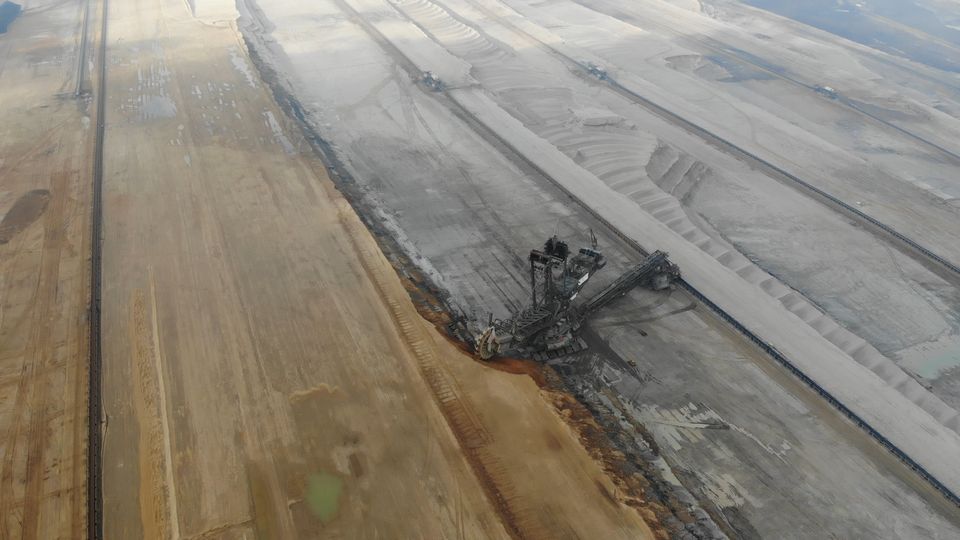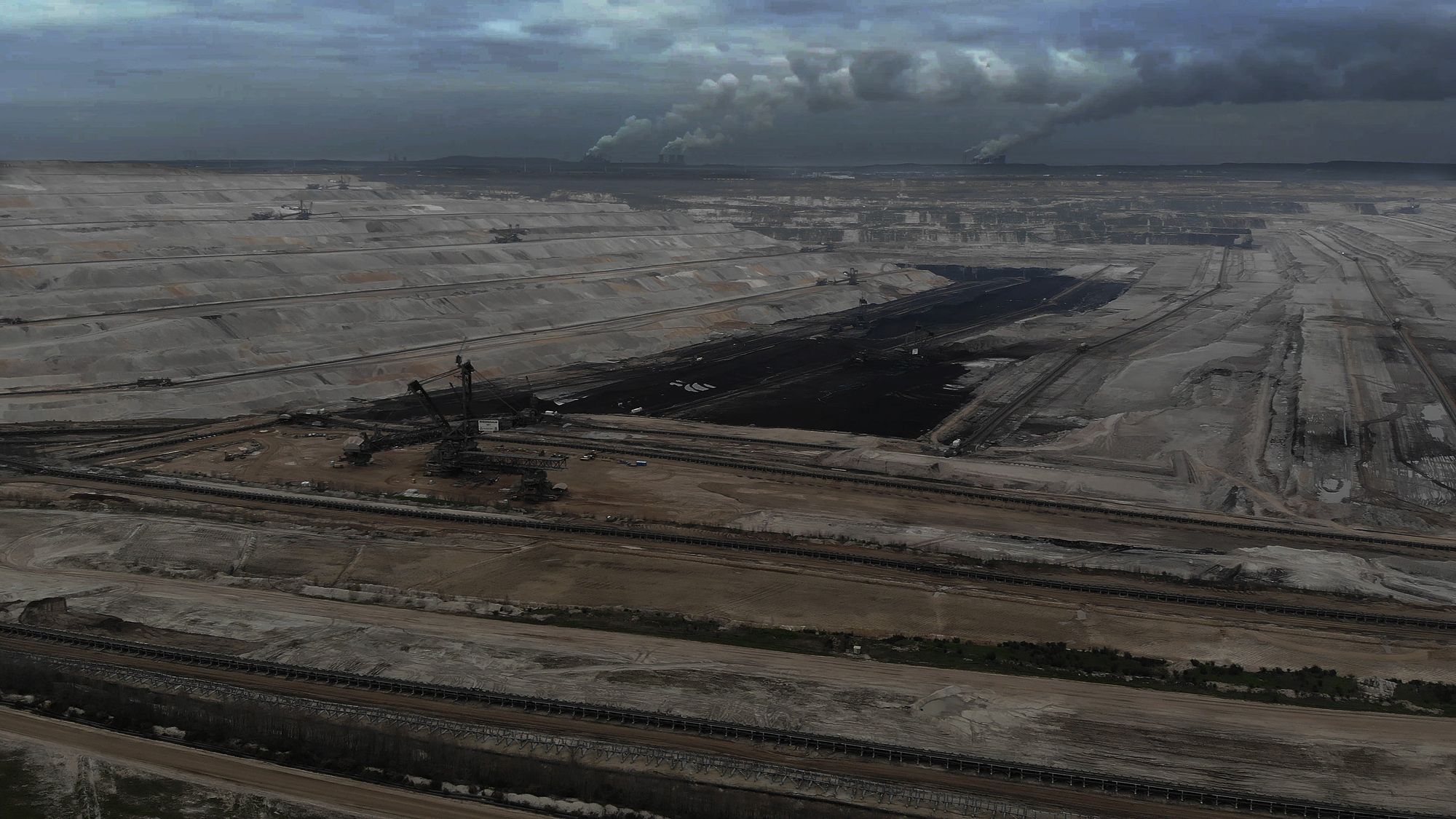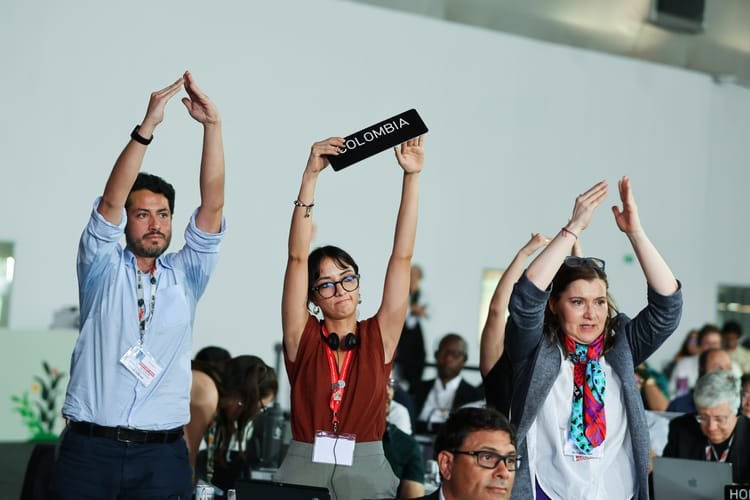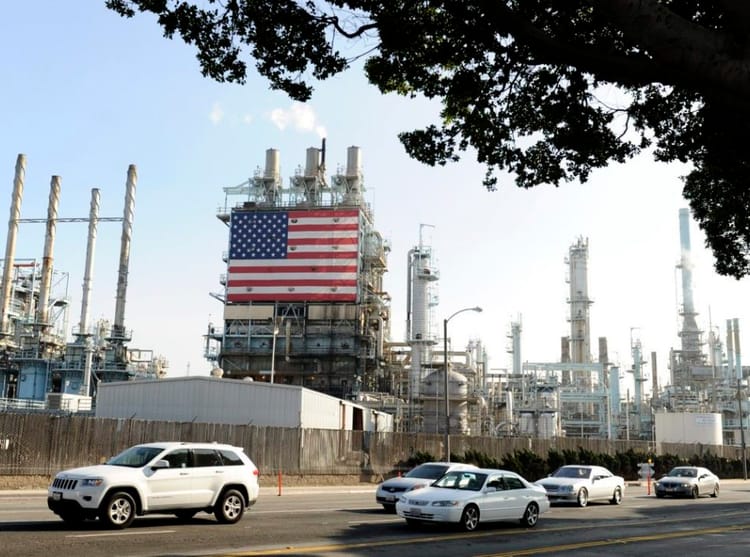Drilled Down: Computer-Aided Destruction

By Maddie Stone
In a two square mile patch of countryside 25 miles west of Cologne, the last surviving remnants of an ancient forest cling to life on the edge of an extractive abyss. Formed about 12,000 years ago at the end of the last Ice Age, the Hambach forest is the largest oak-hornbeam woodland left within Germany’s Atlantic region. It’s a refuge for rare frogs, bats, and over 100 species of birds.
But just a few hundred yards from the forest’s northern edge, gnarled oak trees give way to something else:an open pit the size of Manhattan, where 300-foot tall machines churn through hundreds of feet of soil and rock to extract lignite, one of the dirtiest forms of coal. The site is called Tagebau Hambach, and it is one of Europe’s largest surface coal mines.
These diggers, called “bucket wheel excavators,” have been maintained for decades by German energy conglomerate RWE, which owns the Hambach mine. Resembling creatures out of a Transformers movie, they are among the largest vehicles on Earth, each capable of digging up to 314,000 cubic yards of material per day. Collectively, according to RWE’s website, the seven excavators employed at this mine help extract up to 40 million tons of fossil carbon a year from the former Hambach forest’s blasted bedrock.
Due to their age, size, and complexity, when one of the excavators breaks down, or needs a new part, it’s not a simple mechanical fix. Instead, RWE needs to design and create replacement parts. To accomplish this, for at least a decade in the recent past, the company used 3D design software sold by a California company called Autodesk.
For more than forty years, locals have fought the relentless expansion of the Hambach mine in the courts and in the trees, transforming this region into a battleground for ecological conservation, as well as a symbol of the global climate disaster. The fight has attracted international attention, including a visit from Swedish teen activist Greta Thunberg in 2019.
While activists have mostly focused their ire on RWE, until recently the supporting role played by Autodesk attracted little attention. The firm’s flagship product, a 3D-design platform called AutoCAD, as well as a host of other related apps, are used by architects, engineers, and designers worldwide to scope out new parts, products, machines, buildings, and many other elements of the built environment, and to test them virtually before manufacturing or construction. It is difficult to get a precise handle on Autodesk’s total market share, but industry professionals say that the firm’s apps dominate the computer-aided design market. The 38-year-old company, which currently employs about 10,300 people worldwide, reported 2019 revenues totaling $2.75 billion, and has 4.9 million subscribers to its software.
Autodesk’s low profile in regards to the Hambach coal mine started changing in early 2019, when French artist and climate activist Joanie Lemercier first learned that one of the biggest coal mines on the continent was located just a few hours’ drive from his home in Brussels.
As an artist whose work focuses mainly on creating projections of light to influence the perception of space, Lemercier has long been fascinated by big landscapes. In March 2019, Lemercier visited the mine for the first time, and was struck by the huge scale of the whole operation from the pit itself to the machines working it. “I was very amazed and impressed,” he says. “I was in this weird position where I found it beautiful, but I knew the activity has some terrible impacts.”
Lemercier became obsessed with learning everything he could about the mine. He discovered that RWE had a long history of razing local villages as well as destroying the Hambach forest; and that lignite coal was among the most potent fossil fuels driving climate change. Lemercier also learned that the coal supplied to power plants by this mine was responsible for tens of millions of tons of carbon emissions every year, and that the local power plants burning Hambach mine coal (among other suppliers) were a significant source of regional air pollution. These discoveries added a grim edge to his initial sense of wonder, Lemercier says.
Lemercier also found that he and RWE had something in common: Autodesk’s 3-D modeling software. Lemercier has long used some of the firm’s apps to create artworks, such as three-dimensional scans of buildings for his projections, and designs for sculptures that he then 3-D prints. Via a 2009 case study that Autodesk had posted on its website, he learned that in the past, the company had used the Autodesk mechanical design software to develop replacement parts and new functions for its coal-excavating leviathans.
Lemercier knew people who worked at Autodesk, and had always felt like it was a “great company,” especially because the firm had long played up its commitment to environmental sustainability and solving the climate crisis. So Autodesk’s connection to a fossil fuel giant surprised him. Perhaps, he thought, if he just brought the case study to Autodesk’s attention, someone in a position of authority would realize that supplying software to a coal mine was antithetical to the company’s sustainability commitments, and the partnership would end.
Autodesk isn’t the first tech company that’s come under scrutiny for actively propping up the fossil fuel economy by selling digital services to major carbon polluters. Activists and employees alike have begun publicly criticizing firms like Amazon, Microsoft, and Google for counting oil and gas companies among the customers for their big data tools and cloud hosting services. But the comparatively low-profile Autodesk, which also develops software that is used across the fossil fuel industry, hasn’t been subject to similar criticism.
For more than a decade, Autodesk has made sustainability part of its public image. Today, its list of commitments to environmental responsibility include tracking the impacts of its products on the environment, as well as integrating that information into how it conducts its own business.
But according to several former Autodesk employees familiar with the company’s marketing efforts, the company’s leadership has no real appetite for translating those statements into hard decisions that would affect its bottom line, such as ceasing to license its industry-standard software to fossil fuel companies. Instead, the firm’s professed wokeness is more about projecting an aura of social responsibility, than about fundamentally changing the way it does business.
The structure of Autodesk’s chain of management seems to bear that out. According to the company’s 2019 climate impact reporting to the Carbon Disclosure Project, the Autodesk executive in charge of both sustainability and the firm’s philanthropic Autodesk Foundation, Lynelle Cameron, reports not to CEO Andrew Aganost, but to Autodesk’s vice president of “brand and impact,” Fred Saunders.
The former Autodesk employees Drilled News spoke with requested anonymity because, given Autodesk’s big global footprint in the professional design software industry, they did not want to expose themselves or colleagues both in and outside of the company to possible retaliation.
It is unclear whether RWE still uses Autodesk software exactly as described in the now 11-year-old document Lemercier discovered. Asked for comment, RWE spokesperson Olaf Winter said the company had “no interest in being mentioned in connection with Autodesk.”
According to one of the former Autodesk employees, the fact that the firm did a case study on RWE’s use of Autodesk software in maintaining its bucket wheel excavators likely indicates that the German firm was a customer “of a certain size” at some point. It also suggests that Autodesk considered the partnership significant. At the time the RWE case study was published, RWE had been using Autodesk software for about a decade, and was running “highly customized” training workshops once or twice a year in partnership with CIDEON Systems, an engineering software company and Autodesk platinum partner.
As recently as 2015, CIDEON was still running custom Autodesk training workshops for RWE, according to an article in Cadalyst magazine.
Lemercier began calling Autodesk out on Twitter in the spring of 2019 for its connection to the Hambach coal mine. Not long afterwards the case study disappeared from the firm’s “Company Stories” web page.


Lemercier made his first tweet challenging Autodesk for doing business with RWE on March 30, 2019.
Within hours, Autodesk CEO Andrew Anagnost responded with a tweet of his own, saying that it was “impossible” for the company to police all uses of its software. When Lemercier countered this was a fairly special case, given the Hambach mine’s outsized climate impact, Anagnost acknowledged that Autodesk did not need to highlight the project as a success story on its website.
After more back-and-forth on Twitter, on March 31, Anagnost tweeted to Lemercier that someone from the Autodesk Foundation would reach out to him. Lemercier says nobody ever did.
In early May, after several attempts to contact various company executives via email, Lemercier reached out to Paige Rodgers, the marketing director for the Autodesk Foundation at the time. Three days later, Rodgers responded with an offer to put him on the phone with one of Autodesk’s top executives: Lynelle Cameron, the vice president for sustainability and the CEO of the Autodesk Foundation.
This time, as Lemercier describes it, Autodesk followed through, and about two weeks later, over the phone, Lemercier made his case to Cameron that licensing software to RWE seemed to fly in the face of the company’s sustainability policies.
Cameron seemed “very kind and concerned” about Autodesk’s partnership with the coal company, Lemercier says, but ultimately echoed Anagnost’s Twitter reply that Autodesk had no policy to restrict use of its software. (Lemercier points out that Autodesk does have a “denial list” of off limits entities, including terrorist organizations and manufacturers of weapons of mass destruction.)
According to Lemercier, Cameron nonetheless promised to raise his concerns within the company. After Lemcercier emailed his recap of the call to both Rodgers and Cameron, Rodgers offered to set up another call with Cameron on July 2.
But that call never materialized. According to Lemercier, Rodgers cancelled the call on June 26, explaining in a follow-up email that further contact between Lemercier and Cameron would “ not be a productive use of our time.”
Lemerceier continued attempting to get a response from Autodesk on its business relationship with RWE, repeatedly emailing Cameron and Anagnost to try and restart the conversation. In mid-August he emailed over 250 Autodesk employees, including Cameron and Anagnost, but received no replies. He now believes that around the time Rodgers cancelled his second call with Cameron, the firm blacklisted his email address.
About a week later, on August 24, Lemercier went to Autodesk’s Montreal office in the hope that an in-person visit might lead to a meeting. Instead, an employee called the police. But Lemercier was neither intimidated, nor arrested.
“The officers were actually very nice. We had a brief discussion about the global CO2 emissions and our responsibility to address this issue,” he later tweeted in his account of the visit.
“What struck me the most was how badly [Autodesk] responded,” Lemercier says now. “They just hoped the problem would go away.”
That’s not how Autodesk sees it, according to spokesperson Stacey Doyle. “As a company, whenever valid concerns are raised about our business — whether they come from customers, employees, or our community at large — we take time to listen, assess and address those concerns,” said Doyle in an emailed statement. She did not answer a question about whether the company had made any specific efforts to address Lemercier’s concerns.
Thanks to Lemercier’s Twitter accounts of his interactions with Autodesk, the firm has now joined the list of tech companies that have responded defensively or dismissively to being called out for fossil fuel industry partnerships. Amazon recently attempted to silence employees who were publicly critical of the company’s ever-expanding oil business; the move backfired spectacularly, as The Washington Post reported at the time, with hundreds of employees speaking out against Amazon’s oil contracts and climate policies in a January blog post. When Vice asked Microsoft why it was sponsoring an oil conference the very same week that it pledged to become “carbon negative,” the company feebly responded that it “attends and sponsors a number of events spanning many industries.”
Autodesk is following a Silicon Valley playbook, says Margaret O’Mara, a University of Washington historian who specializes in the technology industry, of positioning itself as an innovator, while evading responsibility for how the world uses its innovations.
“There’s been this cognitive dissonance between the way tech presents itself and also the way it sees itself — we are a kinder, gentler capitalism — and this hope you can have it all,” O’Mara says. When the public starts to realize that for some companies, “having it all” includes morally dubious contracts with defense companies or the oil industry, “it kind of goes against that mythos.”
It’s difficult to estimate the climate impact of software, algorithms, and the other intangible but increasingly indispensable products that flow from Silicon Valley. Companies aren’t required to account for these indirect impacts via the Greenhouse Gas Protocol, a widely used carbon emissions accounting scheme that Autodesk and many other tech companies adhere to, and most don’t even try when including that information would inflate their climate impact.
Chris Preist, a professor of sustainability and computer systems at the University of Bristol in the U.K., notes that the IT sector has a “long history” of attempting to quantify how technology can indirectly reduce global carbon emissions. That includes Autodesk, which has developed tools within some of its software products that can help architects, engineers, and other designers reduce the ultimate carbon footprint of a product or even a building. But according to one former employee, even these efforts haven’t been systematic enough to create lasting change in sectors like building and construction, two of the world’s top carbon polluters by industry, and where Autodesk, thanks to its capture of a substantial part of the professional 3-D design market, is poised to make a real difference.
What’s more, says Preist, even if major technology firms could total up how much their products help users lower their climate footprints, that would only tell half the story. “Tech companies can’t use the fact that their tech can be put to positive use as a get-out clause for reducing their own emissions,” he says, “exactly because tech can be used negatively from a climate point of view.”
If Autodesk were to stop licensing its software to the fossil fuel industry, the move could send a cultural shockwave through Silicon Valley, says O’Mara. Given “the market dominance of these companies, if they decided I’m not gonna participate in XYZ, it does send a powerful signal.”
Former Autodesk employees say that in practice, cutting off a particular industry wouldn’t be an easy decision to implement, because big companies often license software through a series of intermediaries. Some manufacturers may use Autodesk software to make parts for both mining equipment and wind turbines, raising the question of where to draw the line. But, they argue, the challenge of coming up with an effective implementation strategy is no reason not to try.
“To me, something like cutting off the top 100 or top 20, or doing so in a transition period, I would say that is true bold leadership that more companies need to step up and take” one former Autodesk staffer said.
Many financial institutions have begun to see fossil fuels as a dangerous investment amid growing global unrest about the slow pace of climate action. Since 2017 over a dozen major banks, including Lloyds, Barclays, JPMorgan Chase, and Wells Fargo, have ended direct financing of oil and gas extraction projects in the Arctic. Earlier this year, BlackRock, the world’s largest global investment firm with nearly $7 trillion under management (and an Autodesk shareholder), announced that it would be divesting from companies that generate a quarter or more of their revenues from coal production.
Lemercier hopes that Autodesk may be susceptible to the same sort of pressure. He says he is “in discussion” with members of the Bay Area branch of Extinction Rebellion, a global direct action movement that seeks to pressure governments on climate change, to “explore various protest scenarios” at Autodesk headquarters.
Despite Autodesk ceasing all communication with him nearly a year ago, Lemercier believes the company has heard his message. “I’m pretty sure whatever they do,” he says, “they’ve been talking about it internally.”
Meanwhile, western Germany’s giant coal mines show no immediate signs of slowing down. Following a series of legal actions by Friends of the Earth Germany (known by the acronym BUND), RWE has abandoned expansion plans for the Hambach mine that would have obliterated the remaining two square miles of the ancient forest. Its new plan is to carve out the land surrounding the forest, a move that BUND spokesperson Dirk Jansen says will isolate this forest fragment and put additional strain on its wildlife.
With new draft legislation in play in the German legislature that would accelerate the lignite coal sector’s shutdown, RWE has announced that it will close the Hambach mine by 2030. But some nearby villages remain at risk of being razed to make way for another RWE venture in the region, the Garzweiler lignite mine.
Under Germany’s current plan to phase coal out of its energy supply by 2038, both mines could remain in operation for nearly two decades. This would be about eight years past the widely-cited 2018 United Nations deadline for radically reducing emissions to avert the worst effects of climate change.





